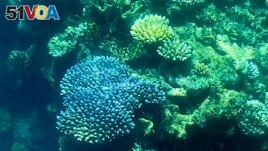14 May 2022
Australian scientists say 91 percent of coral studied in the Great Barrier Reef this year suffered bleaching damage.
Coral gets bleached when ocean temperatures reach unusually warm levels.
The damage to the Great Barrier Reef represents the fourth mass bleaching event to happen in the past seven years, the scientists said. Bleaching in 2016, 2017 and 2020 was blamed for damaging two-thirds of the Great Barrier Reef's coral.

This picture taken on March 7, 2022 shows the coral on the Great Barrier Reef, off the coast of the Australian state of Queensland. The Great Barrier Reef has again been hit with "widespread" bleaching, authorities said on March 18, 2022. (Photo by Glenn NICHOLLS / AFP)
The Great Barrier Reef covers about 344,000 square kilometers of area off Australia's northeast coast. It contains about 3,000 reefs, natural structures made by different kinds of coral. The reef also includes more than 900 islands.
The latest bleaching event is described in a yearly report recently released by the Australian government's Great Barrier Reef Marine Authority.
Coral bleaching can be caused by the effects of climate change. But the scientists said the most recent event was the reef's first bleaching to happen during a La Niña weather period. A La Niña event happens when ocean surface waters cool along the Pacific coast of the South American tropics. This takes place every two to seven years.
Coral suffers bleaching as a reaction to heat stress. But scientists hope that most of the coral will recover from the current event, said David Wachenfeld. He is the chief scientist at the country's Marine Authority, which oversees the reef's ecosystem. Wachenfeld told The Associated Press that early signs so far suggest "the mortality won't be very high."
He compared the latest event to the one that happened in 2020. That event produced mass bleaching, but there was low mortality, meaning the coral largely did not die. The bleaching events in 2016 and 2017 led to "quite high levels of coral mortality," Wachenfeld said.
Simon Bradshaw is a researcher at Australia's Climate Council environmental group. He told the AP the latest report demonstrates that the reef's survival depends on deep cuts in worldwide carbon emissions over the next 10 years.
"This is heartbreaking. This is deeply troubling," Bradshaw said. "It shows that our Barrier Reef really is in very serious trouble."
I'm Bryan Lynn.
The Associated Press reported this story. Bryan Lynn adapted the report for VOA Learning English.
We want to hear from you. Write to us in the Comments section, and visit 51VOA.COM.
___
Words in This Story
coral – n. a hard, usually pink or white substance produced by a type of very small sea animal
bleaching – n. a process, usually caused by warm ocean temperatures, in which corals lose algae and turn white
tropics – n. (pl.) parts of the world that are near the equator and, therefore, are usually warm
stress – n. physical forces that affect something
ecosystem – n. everything that exists in a particular environment
emission – n. the act of producing or sending out something (such as energy or gas) from a source
heartbreaking – adj. causing extreme worry and sadness










